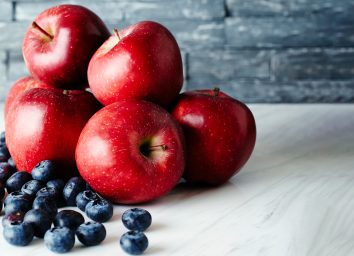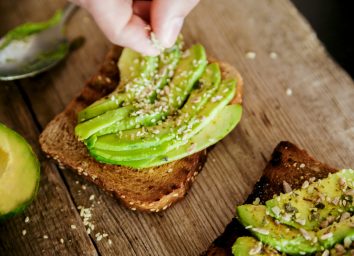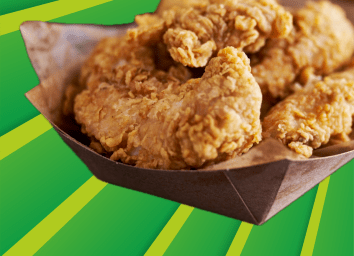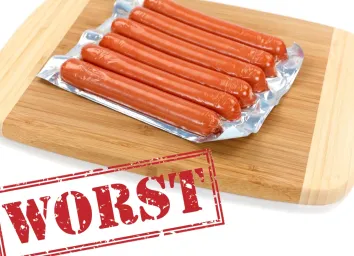This High Cholesterol Diet Plan Will Lower Your Cholesterol Numbers
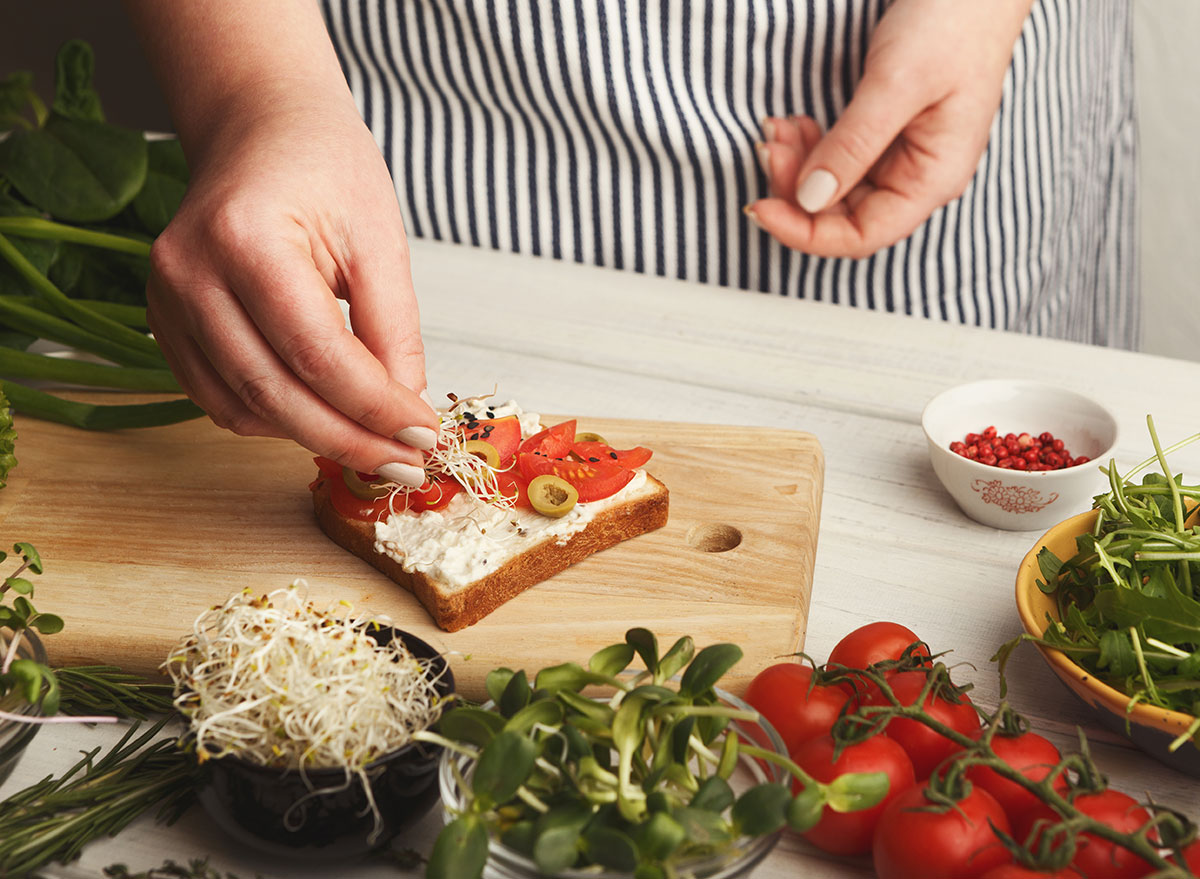
In a perfect world, every time you’d go for a blood test, all your numbers would come back within optimum ranges. You’d skip off into the sunset from your doctor’s office assured of your clean bill of health. In reality, though, we don’t always get the results we hope for. It’s not uncommon for a blood test to reveal that your cholesterol is high, which is why following a high cholesterol diet plan can be useful.
Because we’ve all heard about the connection between blood cholesterol and heart disease, finding out your HDL or LDL is out of whack can be a downer. Thankfully, though, your diet can go a long way toward bringing your numbers back into a healthy range. And while you may think a diagnosis of high cholesterol means you’re doomed to a lifetime of rabbit food, never fear! A cholesterol-lowering diet plan can actually be full of satisfying, interesting options.
We spoke to health pros to get the scoop on how to eat for healthy blood cholesterol.
What your numbers mean
Looking at your blood test results, you’ve probably noticed that there are two types of cholesterol, LDL and HDL. You may have also heard that there’s “good” cholesterol and “bad” cholesterol, both of which are important in evaluating your cardiovascular health. Confused yet?
A quick refresher: LDL, or low-density lipoprotein, is the “bad” kind of cholesterol. It transports tiny droplets of fat throughout the body, depositing them in your arteries, where they block blood flow. (You can think of the “L” in LDL as the kind of cholesterol to keep low.) HDL, or high-density lipoprotein, on the other hand, is the “good” kind of cholesterol that helps cleanse your blood vessels of the gnarly gunk that can clog them. (Try remembering that this “H” number is the helpful one you want to keep high).
You can take different measures to change your LDL and HDL through a diet, but in general, dietary tips for raising one and lowering the other don’t conflict. If both your numbers need adjusting, there’s no need for two separate diet plans.
The basics of a cholesterol-management diet
Does cholesterol in food matter?
Theoretically, it’s logical to assume that the more cholesterol you eat in food, the more the cholesterol you’ll have in your blood. At least, that’s what researchers used to believe. But in recent years, this theory has been debunked. A 2010 study revealed that most of the research supporting this idea was conducted on animals. In humans, evidence that eating cholesterol leads to unhealthy numbers simply isn’t there. In fact, the 2015-2020 Dietary Guidelines for Americans makes no recommendation to limit cholesterol in foods. “Cholesterol in food only plays a minor role in the cholesterol found in our blood,” confirms Kris Sollid, RD, Senior Director of Nutrition Communications at the International Food Information Council. “[It] is no longer considered a nutrient of concern for overconsumption.”
So if the cholesterol in our eggs and red meat isn’t the bogeyman of heart disease, what actually does make an impact? Two things: fiber and fat.
The role of fiber
While both soluble and insoluble fiber are helpful, soluble fiber is cholesterol management’s top dietary rock star. Intriguingly, scientists aren’t 100 percent sure why it works, but it’s likely that this type of fiber binds to cholesterol particles in the digestive system, flushing them out of the body before they have a chance to be absorbed. Whatever the cause, one thing’s for sure: getting plenty of soluble fiber through foods like black beans, oat bran, avocadoes, and brussels sprouts can both raise good cholesterol and lower bad cholesterol.
The role of fat
The next nutrient in the two-pronged dietary approach to cholesterol is fat. Different types of fat can have different effects on your cholesterol, for good or ill. Above all else, for healthier numbers, ruthlessly eliminate trans fats from your high cholesterol diet. These harmful fats have the dubious distinction of both raising bad cholesterol and lowering good cholesterol. Although artificial, man-made versions of trans fats have technically been banned in the U.S., they may still lurk in some food products. Check labels for any kind of hydrogenated oils—this is “code” for trans fat.
On the flip side, there’s one kind of fat the cardiovascular system loves: heart-healthy omega-3s. “Getting enough omega-3 fatty acids (think fatty fish, flaxseed, and walnuts), a type of polyunsaturated fat, can help increase HDL cholesterol,” says Sollid. Omega-3s’ impact may also have to do with how they alter triglycerides—another line item on your blood test. Lowering triglycerides can mean lowering cholesterol, and vice versa.
“Very high triglycerides can raise total cholesterol,” says cardiologist and lipidologist Dr. Robert Greenfield, MD. “Oily fish such as salmon, herring, sardines, etc. can lower triglycerides.” Aim to get seafood in your high cholesterol diet at least twice a week, like with healthy seafood recipes.
As for saturated fat’s influence on cholesterol levels, expert opinions are mixed. For ages, medical wisdom held that saturated fat led to clogged arteries. But the last several years have seen a shift. A meta-analysis in the British Medical Journal found that the intake of saturated fat wasn’t linked to a higher risk of coronary heart disease or cardiovascular disease. And the beneficial nutrients in foods like full-fat dairy, for example, may outweigh the consequences of their saturated fat content.
Overall, it’s definitely wise to stay away from processed foods that contain high amounts of saturated fat. As for whole foods that contain saturated fat, such as milk or red meat, the jury is still out on exactly how they affect blood cholesterol. Until we know more, many experts urge those with high cholesterol to eat these foods in moderation.
Portion control for better numbers
As you’re planning a high cholesterol diet, don’t forget that portion control matters, too. Your body weight can have a surprising effect on your cholesterol. “If someone is overweight or obese, they can reduce LDL cholesterol and increase HDL cholesterol by losing as little as 3 percent to 5 percent of their body weight,” says Sollid. For healthy weight loss, aim to lose no more than one to two pounds per week.
Why have diet recommendations changed for cholesterol?
If you have the sense that dietary recommendations around cholesterol have changed in the last couple of decades, you’re not wrong. Why is it that eggs used to be bad and now they’re fine, or that saturated fat isn’t the problem we thought it was?
The fact is, nutrition research is a constantly evolving field. “For those that follow the evolution of nutrition science closely, the shifts are gradual and logical. But for those who do not follow it closely, the shifts can seem like they come out of left field,” says Sollid.
Rest assured that current recommendations aren’t being made willy-nilly. “It’s important for people to know that major changes in dietary guidance don’t occur because of one single study that makes media headlines,” says Sollid. “Rather, shifts are made after a compilation of the highest-quality evidence is reviewed.”
Foods to eat to improve cholesterol
To lower cholesterol, try building meals and snacks around whole, unprocessed foods as much as possible. Here are some to include.
- Whole grains: Oats, barley, whole wheat bread, whole-wheat pasta, brown rice, quinoa, amaranth, and farro.
- High-fiber, nutrient-dense vegetables: Leafy greens, brussels sprouts, broccoli, cauliflower, peppers, zucchini, carrots, cucumbers, green beans, and tomatoes.
- High-fiber, antioxidant-rich fruits: Berries, citrus fruits, bananas, apples, pears, peaches, and melon.
- Fatty fish: Salmon, tuna, herring, mackerel, and anchovies.
- Lean protein: Chicken, turkey, beans, nuts, lentils, tofu, tempeh, and edamame.
- Dairy: Yogurt, kefir, milk and (occasionally) cheese.
- Antioxidant, anti-inflammatory herbs and spices: Ginger, garlic, turmeric, and basil.
Foods to avoid to improve cholesterol
To keep your numbers in check, stay away from high-sugar, highly processed, and empty-calorie foods. Here are some to watch out for.
- Fried foods: French fries, onion rings, fried chicken, potato chips.
- Processed meals and snacks: Boxed meal mixes, fast food, hot dogs, cookies, bakery products, fruit snacks, and candies.
- Refined grains: White bread, white pasta, white rice, and white flour in baking.
- Sweetened beverages: Juice, soda, energy drinks, and excessive amounts of alcohol.
Special diets for high cholesterol
There’s compelling evidence that certain special diets can help pull your cholesterol numbers into the healthy range. The DASH diet, which stands for Dietary Approaches to Stop Hypertension, has been found to reduce LDL and raise HDL.
Some studies have also linked the Mediterranean Diet to a reduced risk of heart disease from clogged arteries.
“I recommend both the DASH and Mediterranean diets,” says Greenfield, “as they stress the ingestion of fish, poultry, fruits, vegetables, legumes, seeds, nuts, and plenty of water.” As for other diet trends, like keto and paleo, more research is needed to determine their potential influence. Talk to your doctor if you’re currently on (or would like to start) a particular diet plan.
Sample meal plan for high cholesterol
- Breakfast: 2 slices whole-wheat toast topped with 1/2 a mashed avocado, sprinkled with salt and pepper
- Lunch: Tuna salad wrap: 3 oz. tuna, 1 tablespoon mayonnaise, 1/2 cup chopped apples, and 1 tablespoon pecan pieces in a whole wheat tortilla; 1 small package baked chips; green salad: 2 cups fresh spinach, 1/4 cup grated carrots, 1 tablespoon olive oil-based dressing
- Snack: 2 graham crackers with 1 tablespoon peanut butter
- Dinner: Grain bowl: 1.5 cups cooked quinoa, 1/2 cup chickpeas, 1.5 cups roasted broccoli, carrots, and red onion blend, olive oil and lemon juice to taste
- Dessert: Yogurt parfait: 1 cup 2% Greek yogurt, 1/2 cup fresh or frozen berries, 2 tablespoon granola, and a drizzle of honey
How long does it take to lower cholesterol through diet?
Before making major changes to your diet, you probably want to know how long it will take before you see results in your bloodwork. “It takes time for the body to respond and change,” says Greenfield, who notes that this process may take a few months. However, it’s the slow and steady progress that usually makes the longest-lasting impact. Greenfield sees this as a positive for ensuring a healthy future. “You are now establishing heart-healthy habits that you need to carry you to a healthy, ripe age.”
